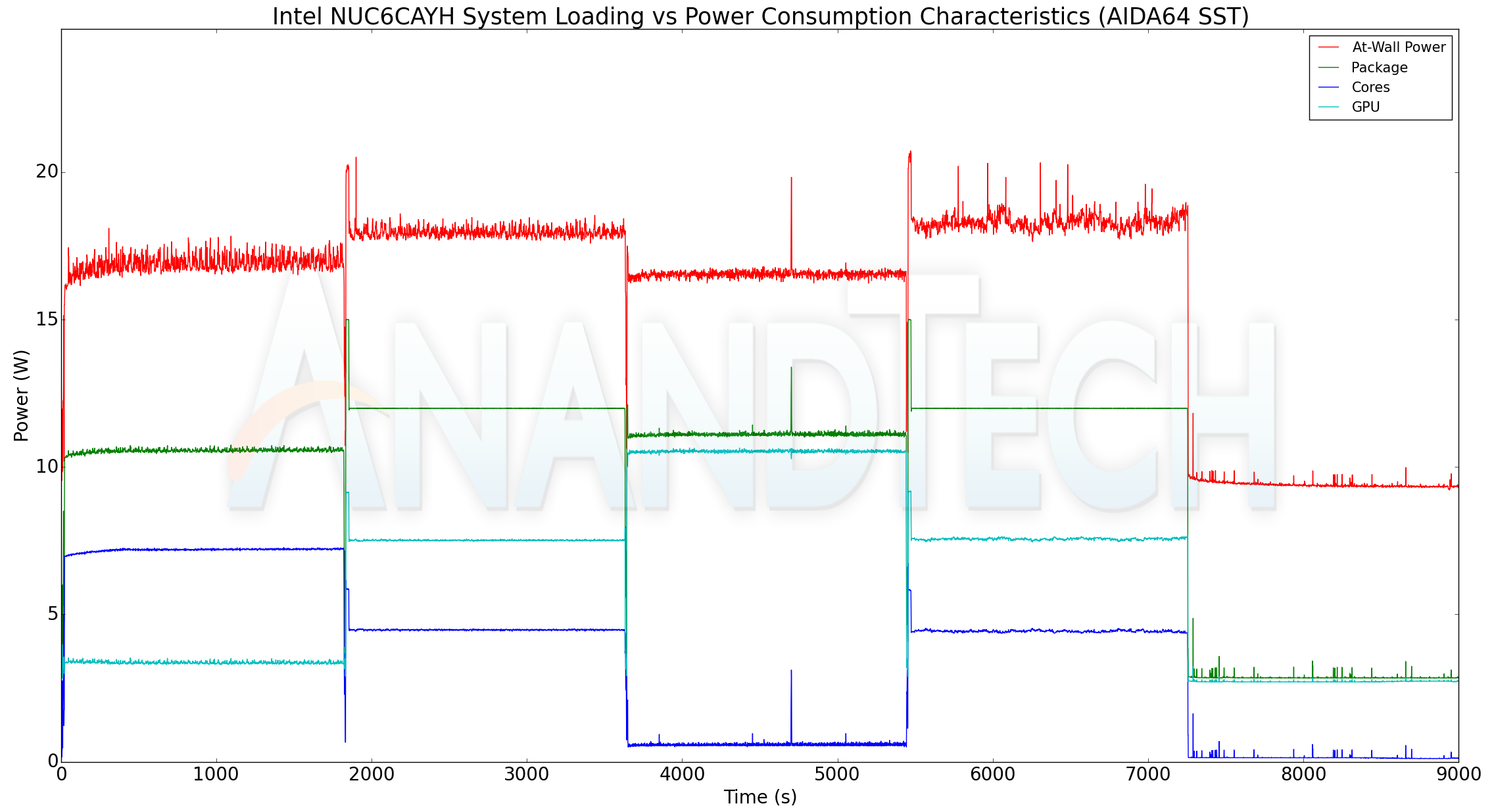Intel NUC6CAYH (Arches Canyon) Apollo Lake UCFF PC Review
by Ganesh T S on January 12, 2018 8:00 AM EST- Posted in
- Systems
- Intel
- NUC
- UCFF
- Apollo Lake
- Arches Canyon
Power Consumption and Thermal Performance
The power consumption at the wall was measured with a 4K display being driven through the HDMI 2.0 port. In the graphs below, we compare the idle and load power of the Intel NUC6CAYH with other low power PCs evaluated before. For load power consumption, we ran the AIDA64 System Stability Test with various stress components, as well as our power virus test, and noted the maximum sustained power consumption at the wall.


The Intel NUC6CAYH has a powerful CPU that wins in a majority of the presented benchmarks. But, it comes with a significant power penalty, both at idle and full loading.
Our thermal stress routine starts with the system at idle, followed by four stages of different system loading profiles using the AIDA64 System Stability Test (each of 30 minutes duration). In the first stage, we stress the CPU, caches and RAM. In the second stage, we add the GPU to the above list. In the third stage, we stress the GPU standalone. In the final stage, we stress all the system components (including the disks). Beyond this, we leave the unit idle in order to determine how quickly the various temperatures in the system can come back to normal idling range. The various clocks, temperatures and power consumption numbers for the system during the above routine are presented in the graphs below.
| Intel NUC6CAYH - AIDA64 System Stability Test | |||

According to the official specifications of the Intel Celeron J3455, the junction temperature of the SoC is 105C. We do not see the numbers go anywhere that in the AIDA64 SST processing of the system. Interestingly, the package power seems to be configured for around 12.5W instead of 10W (as dictated by the TDP).
The AIDA64 system stability test uses real-world workloads to stress the system components. However, power virus tests such as the Prime 95 torture test and Furmark stability test can subject the system to greater stress. We repeated our thermal stress routine with 30 minutes of Prime 95 (v29.1), followed by 30 minutes of Prime 95 and Furmark (1.19.1). The Prime 95 load was then removed, and the GPU stressing Furmark test was allowed too run for another 30 minutes. The various clocks, temperatures and power consumption numbers for the system during the above routine are presented in the graphs below.
| Intel NUC6CAYH - Custom System Stability Test | |||

Here, we see the temperatures going up to 100C, but there is no throttling involved. Peak sustained power consumption numbers are also higher than what we encountered in the AIDA64 system stability test.










54 Comments
View All Comments
lilmoe - Thursday, January 18, 2018 - link
Can this decode 4k60p HEVC HDR with little to now CPU usage and under 2w? No? Didn't think so.mode_13h - Saturday, January 20, 2018 - link
Unfortunately, he reviewed a NUC that's > 1 year old. The new Gemini Lake SoCs can do 4k60 @ 10bit HEVC, with native HDMI 2.x.In 2W? I don't know but maybe close to that, and for less $$$ than any phone or tablet that could do it.
Anyway, I wouldn't say Goldmont or Goldmont+ can run circles around a modern, high-end ARM core. But, if you check out the benchies, they're definitely in the same ballpark.
Arbie - Friday, January 12, 2018 - link
Good luck keeping Windows 10 updated on the 32GB machine. No more of those for me.smegforbrain - Friday, January 12, 2018 - link
Yeah, we tried one of these out at the office. Out of the box with nothing but the Creators Update installed, and it didn't have the space to install the Fall Creators Update. Now I'm not sure what the hell to do with it.69369369 - Saturday, January 13, 2018 - link
Use it to cook marshmallows?Badelhas - Monday, January 15, 2018 - link
I am having the exact same problem, had to connect an external drive to be able to update Windows 10. Incredible.jimjamjamie - Monday, January 15, 2018 - link
put linux on it :Djabber - Monday, January 15, 2018 - link
I've had a couple of those 32GB trash heaps in to put the main updates on.Basically did it two ways. Deleted as much of the non OS software and data off, did the update and put it all back.
Or...compressed the drive after cleaning it up. Makes little difference to performance. In fact I now use full disk compression on several small SSDs I use.
mode_13h - Monday, January 15, 2018 - link
32 GB is plenty for a Linux install.Kronos288 - Saturday, January 13, 2018 - link
Hey ganesh,I set three of these up recently to run permanent displays. Thanks for the review. Might be worthy to note these two things as well:
These NUCs are very picky about the type of ram modules. I originally purchased a crucial double pack, but the bios spit out a ram density error. There's an article on Intel's website on selecting compatible ram and there's a list.
Lastly, if you plan on using it for displays like me, you need to perform the latest bios update to add the HDMI CEC functionality... Although it only supports power on or power off and not pass through for accessories like media remotes. Does have IR built in though.
Oh and the kits include a Vesa mounting bracket. Cheers.